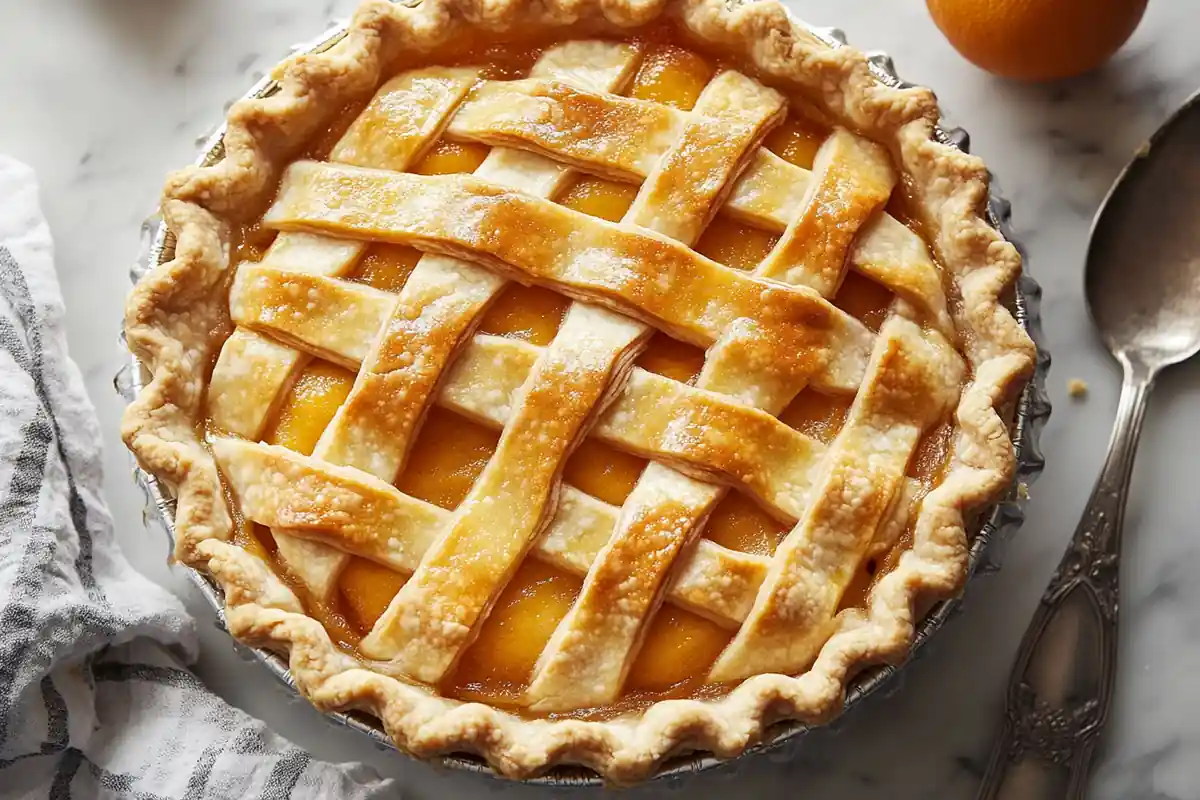A detailed guide to mastering a Crisco pie crust recipe. Perfect for both beginners and seasoned bakers, this article covers every aspect you need.
The Magic of a Perfect Crisco Pie Crust Recipe
Making a flaky, tender Crisco pie crust recipe is an art. Consequently, it involves understanding ingredients and techniques. Therefore, this article provides a comprehensive guide. You will learn each step thoroughly. Additionally, we cover tips for success.
Why Choose Crisco for Your Pie Crust?
Crisco is a vegetable shortening. Specifically, it’s a popular choice for pie crusts. Because of its high fat content, Crisco produces tender results. Furthermore, it’s easy to work with. Compared to butter, Crisco has a higher melting point. This prevents it from getting too soft too quickly. However, butter can also work well in pie crusts. Additionally, it is important to know the difference.
Crisco Pie Crust Recipe: Key Ingredients
The base of any good Crisco pie crust recipe is simple. Generally, you’ll need flour, salt, water, and shortening. However, the quality of each ingredient matters. Therefore, make sure to use the best ingredients you can. Flour provides structure, so use all-purpose. Salt enhances flavor. Water binds the dough. Crisco provides that all-important flaky texture.
Step-by-Step: How to Make a Crisco Pie Crust Recipe
The following is a detailed guide to baking Crisco pie crust. This recipe is easy to follow. Consequently, you will have a flaky pie crust.
- Measure Dry Ingredients: Firstly, measure your flour and salt. Combine these ingredients in a large bowl. Whisk them together. This evenly distributes the salt.
- Cut in the Crisco: Next, add the cold Crisco shortening. Use a pastry blender or fork to cut it into the flour mixture. Continue until the mixture resembles coarse crumbs. Do this gently. This ensures the best results.
- Add Cold Water: Gradually add very cold water. Mix it gently until the dough begins to come together. Do not overmix it. Overmixing will lead to a tough crust.
- Form the Dough: Form the dough into a disk. Wrap it in plastic wrap. Afterward, refrigerate for at least 30 minutes. This allows the gluten to relax. Consequently, it makes the dough easier to roll.
- Roll Out the Dough: Once chilled, roll out the dough. Lightly flour your surface to prevent sticking. Roll from the center outward. Work gently to avoid tearing.
- Transfer to Pie Plate: Carefully transfer the rolled dough to your pie plate. Trim off any excess dough hanging over the edges. Crimp the edges with a fork or your fingers for a beautiful presentation.
- Bake or Blind Bake: Finally, either fill and bake or blind bake your pie crust. Follow your recipe instructions carefully. Always preheat your oven.
Tips for a Perfect Crisco Pie Crust Every Time
Many small tips can make big differences. Furthermore, follow these simple tips. You will see consistent, successful results each time.
- Keep Everything Cold: It is crucial that all ingredients be cold. Chilled ingredients help create a flaky crust. Use ice water. Refrigerate your Crisco, too.
- Don’t Overwork the Dough: Overmixing develops the gluten. Therefore, the crust will be tough. Mix only until just combined.
- Handle the Dough Gently: The dough is delicate. Therefore, roll it out lightly. If it gets too warm, return it to the fridge.
- Use a Pastry Blender: A pastry blender makes the cutting-in process efficient. It helps create an even crumb.
- Chill Your Dough: Allowing the dough to chill is extremely important. This step makes the dough more manageable. Additionally, it prevents shrinkage during baking.
Troubleshooting Common Crisco Pie Crust Problems
Even experienced bakers face problems sometimes. Therefore, it’s important to know how to address them. For example, a tough crust can be caused by overmixing. A soggy crust might result from underbaking or using wet fillings. A shrinking crust could be from not chilling the dough properly.
- Tough Crust: Overmixing is the main culprit. To prevent this, mix only until combined. Handle the dough gently.
- Soggy Crust: Blind bake your crust. This helps pre-cook the dough. Also, make sure you don’t use fillings that are too wet.
- Shrinking Crust: Chill your dough adequately. Avoid overworking it. Furthermore, use proper baking temperatures.
Variations to Your Crisco Pie Crust Recipe
While the basic recipe is wonderful, there is always room for experimentation. Thus, consider these variations for further creativity.
Sweet and Savory Options
A basic Crisco pie crust recipe works well for both sweet and savory pies. However, some slight adjustments can make it even better. You can add sugar for a sweeter taste. Herbs and spices enhance savory flavors. Therefore, match the seasoning to your pie filling.
- Sweet: Add 1-2 tablespoons of granulated sugar to the dry ingredients.
- Savory: Include 1-2 teaspoons of dried herbs. Consider rosemary, thyme, or sage. Also, you could add a dash of black pepper.
Using Different Flours
While all-purpose flour is the standard, exploring other flours is a good idea. This will change the texture and taste of your Crisco pie crust. Therefore, consider using these other options:
- Whole Wheat Flour: Substituting part of the all-purpose with whole wheat. This will provide a nuttier flavor. Start with 1/4 to 1/2 substitution.
- Pastry Flour: This will provide an even more tender texture. It has lower protein content. You can fully substitute it for all-purpose.
- Gluten-Free Flour Blend: This option helps if you have dietary restrictions. Use a 1-to-1 substitution for all-purpose.
Adding Flavor Boosters
Flavor boosters can elevate the simple Crisco pie crust recipe. Thus, try some of these ideas:
- Lemon Zest: Add the zest of one lemon for a subtle citrus flavor. This works well with fruit pies.
- Vanilla Extract: Incorporate half a teaspoon of vanilla. It adds extra warmth.
- Spices: Include a pinch of cinnamon or nutmeg. Perfect for fall and winter pies.
Using Your Crisco Pie Crust
After you make a perfect Crisco pie crust, you will want to use it in delicious pies. Therefore, the possibilities are limitless.
Delicious Pie Filling Ideas
You can create many kinds of pie fillings. This is a chance to be creative and personalize your recipe.
- Fruit Pies: Apple, cherry, berry, peach. These are classic and always beloved.
- Cream Pies: Chocolate, coconut, vanilla. Cream pies offer smooth, rich flavors.
- Pecan Pie: This classic is rich and nutty. It’s perfect for special occasions.
- Savory Pies: Chicken pot pie, spinach quiche, vegetable tart.. These are perfect for any meal.
Assembling Your Pie
Before baking, assemble your pie well. Therefore, this ensures the most success.
- Prepare the Filling: First, make sure your filling is prepared as needed. Do this while the crust is chilling.
- Fill the Crust: Add the filling evenly to the prepared pie crust. Do this carefully to avoid spilling.
- Top Crust: If making a double-crust pie, place the top crust. Vent holes are necessary to allow steam to escape.
- Crimp and Bake: Crimp the edges. Bake at the recommended temperature.
Storage Tips for Crisco Pie Crust
Storing your Crisco pie crust properly is key. This keeps it fresh and ready to use.
- Unbaked Crust: Wrap the dough tightly in plastic wrap. Keep in the refrigerator for up to three days. Alternatively, freeze for up to three months.
- Baked Crust: Allow the crust to cool completely. Cover with plastic wrap. Then, store at room temperature for a day or two. You can store it in the fridge for longer.
- Baked Pie: Store leftover pie in the refrigerator. Cover it well to keep it fresh.
Health Aspects of Crisco Pie Crust Recipes
When it comes to Crisco pie crusts, consider the health aspects. Thus, be mindful of the ingredient choices.
Comparing Crisco to Other Fats
Crisco is a vegetable shortening. Therefore, it differs from butter and lard. However, each option has its advantages.
- Butter: Provides a rich flavor. However, it has a lower melting point. It can be more difficult to work with.
- Lard: Offers great flavor and flakiness. However, it’s not a vegetarian option. Its flavor is unique.
- Crisco: Provides consistent results and is easy to work with. It is also plant-based.
Understanding Nutritional Values
Like any ingredient, Crisco has its nutritional profile. Therefore, it’s essential to be aware of this. Crisco is higher in saturated fat than some other oils. However, it’s important to use in moderation.
- Saturated Fat: High in saturated fat. Limit overall consumption in your diet.
- Trans Fat: Make sure it is made without trans fats. This is something to be mindful of.
- Overall Health: Use in moderation as part of a balanced diet.
Making Healthier Choices
There are ways to make Crisco pie crust recipes a bit healthier. Therefore, be mindful of your ingredients and process.
- Use Less Fat: Reduce the amount of fat slightly. However, this might change the texture.
- Whole Wheat Flour: Use a portion of whole wheat flour. This can add fiber to your crust.
- Focus on Natural Fillings: Choose fillings made with fresh fruits and vegetables. Avoid processed ingredients.
Final Thoughts on the Crisco Pie Crust Recipe
Mastering a Crisco pie crust recipe can open up a world of baking possibilities. For example, you can create many kinds of pies. Therefore, follow these steps closely. Your pies will become a crowd-pleaser. Crisco ensures a flaky texture. Consequently, this makes it ideal for consistent baking. Finally, enjoy baking and creating many amazing pies. The key is to practice and have fun with it.
Frequently Asked Questions
Is pie crust better with butter or Crisco?
Butter provides a richer flavor. Crisco, however, produces a flakier crust. Both options can be used effectively. The choice depends on your desired taste and texture.
Why is my Crisco pie crust falling apart?
This could be because the dough is too dry or it hasn’t been chilled enough. Try adding a little more cold water. Remember to chill the dough well before rolling.
Should shortening be refrigerated for pie crust?
Yes, it’s best to refrigerate Crisco. This ensures that it is cold. Cold shortening helps create a flakier crust. Also, cold ingredients in general are crucial.
What is one thing you should not do when making pie crust?
Avoid overmixing the dough. Overmixing develops the gluten. This results in a tough crust. Mix only until just combined.

